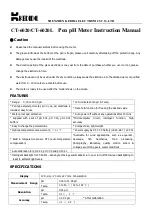
33
USER MANUAL
RETEVET™ PORTABLE ERG
T +49 7461 96 580 0 | F +49 7461 96 580 90 | [email protected] | www.eickemeyer.com
An Error Code is Reported
Error codes are reported for failures unlikely to be correctable in the fi eld. Record the error code and contact the
EICKEMEYER® customer service. In addition, save and send to EICKEMEYER®
any fi les found in the / Diagnostics folder on
the device. When error codes are displayed, the RETevet™ device may give the option of performing a factory reset. The factory
reset option may also occur if the USB fi le system has been corrupted due to, for example, removing the device from the
docking station while fi les were being transferred. A factory reset returns the device to the as-shipped condition by
reformatting the device, deleting all data, custom protocols, and customization in order to attempt to return the device to
working order. We recommend not performing a factory reset on the fi rst time an error code is reported.
9. REFERENCES
• Ahmadi, M, and Q Q Rodrigo. 2013. “Automatic denoising of single-trial evoked potentials.” NeuroImage:672-680.
• Dembinska, O., L. M. Rojas, S. Chemtob, and P. Lachapelle. 2002. “Evidence for a brief period of enhanced oxygen susceptibility
in the rat model of oxygen-induced retinopathy.” Invest Ophthalmol Vis Sci 43 (7):2481-90.
• Dembinska, O., L. M. Rojas, D. R. Varma, S. Chemtob, and P. Lachapelle. 2001. “Graded contribution of retinal maturation to
the development of oxygen-induced retinopathy in rats.” Invest Ophthalmol Vis Sci 42 (5):1111-8.
• Ekesten, B., A. M. Komaromy, R. Ofri, S. M. Petersen-Jones, and K. Narfstrom. 2013. “Guidelines for clinical electroretinography
in the dog: 2012 update.” Doc Ophthalmol 127 (2):79-87. doi: 10.1007/s10633-013-9388-8.
•
McAnany, J, and P Nolan. 2014. “Changes in the harmonic components of the fl icker electroretinogram during light
adaptation.” Doc Ophthalmol:1-8.
• McGee, D. H., O. Dembinska, and M. M. Gruebbel. 2005. “Evaluation of triamcinolone acetonide following intravitreal
injection in New Zealand white rabbits.” Int J Toxicol 24 (6):419- 25. doi: 10.1080/10915810500366864.
•
Mentzer, A. E., D. M. Eifl er, F. Montiani-Ferreira, N. Tuntivanich, J. Q. Forcier, and S. M. Petersen-Jones. 2005. “Infl uence of
recording electrode type and reference electrode position on the canine electroretinogram.” Doc Ophthalmol 111 (2):95-
106. doi: 10.1007/s10633-005-4517-7.
• Miyadera, K., G. M. Acland, and G. D. Aguirre. 2012. “Genetic and phenotypic variations of inherited retinal diseases in dogs:
the power of within- and across-breed studies.” Mamm Genome 23 (1-2):40-61. doi: 10.1007/s00335-011-9361-3.
• Polosa, A., S. Lv, W. Ait Igrine, L. A. Chevrolat, H. Bessaklia, and P. Lachapelle. 2019. “Evidences Suggesting that Distinct
Immunological and Cellular Responses to Light Damage Distinguishes Juvenile and Adult Rat Retinas.” Int J Mol Sci 20 (11).
doi: 10.3390/ijms20112744.
•
Severns, Matt, Mary Johnson, and Scott Merritt. 1991. “Automated estimation of implicit time and amplitude from the fl icker
electroretinogram.” Applied Optics:2106-12.
•
Tuntivanich, N., A. L. Mentzer, D. M. Eifl er, F. Montiani-Ferreira, J. Q. Forcier, C. A. Johnson, and S. M. Petersen-Jones. 2005.
“Assessment of the dark-adaptation time required for recovery of electroretinographic responses in dogs after fundus
photography and indirect ophthalmoscopy.” Am J Vet Res 66 (10):1798-804. doi: 10.2460/ajvr.2005.66.1798.
















































